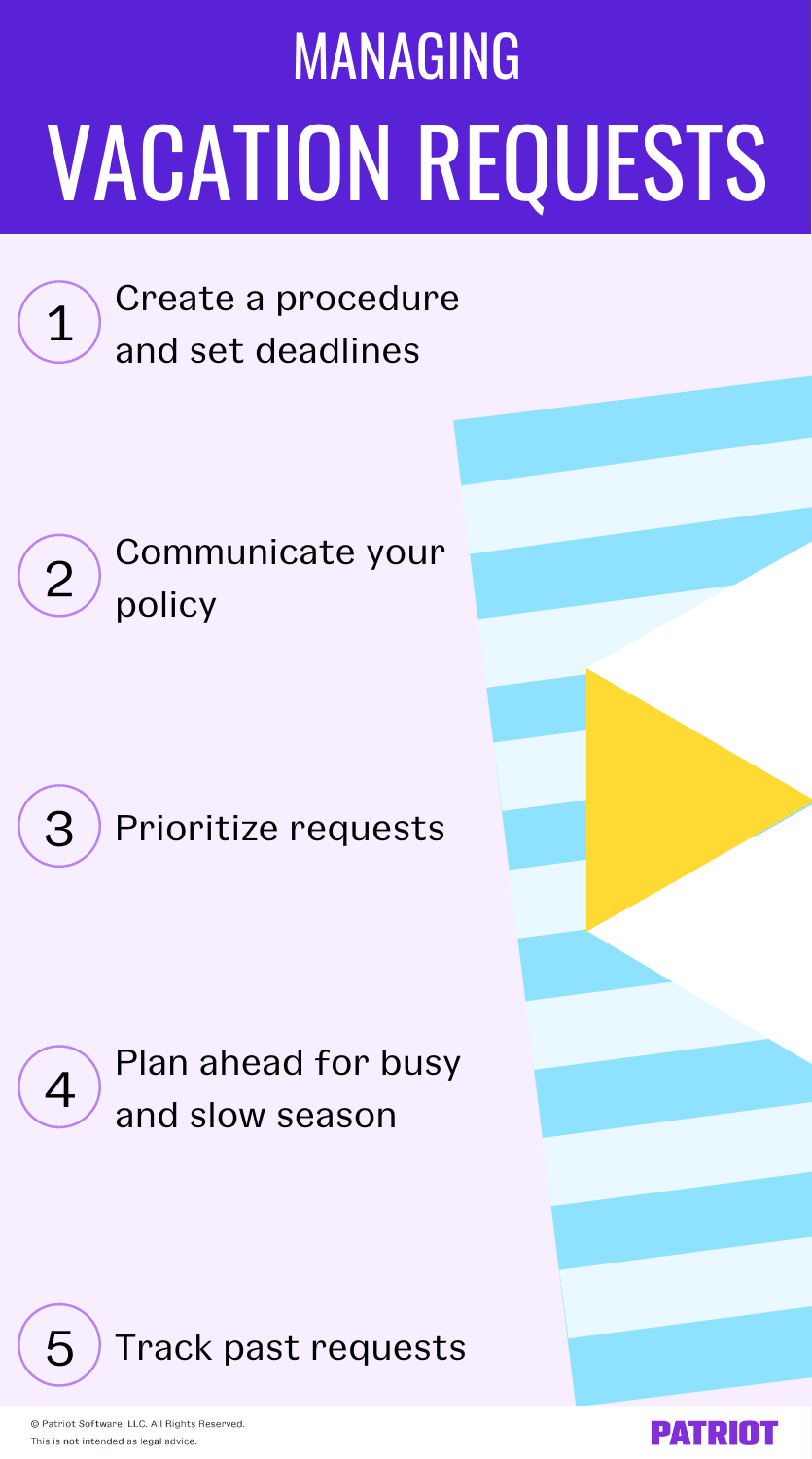As an employer, you face the challenge of juggling employees’ vacation requests. It can be difficult to find the perfect balance of being flexible while ensuring your business has enough coverage. To keep things fair and square, learn the ins and outs of managing vacation requests.
Managing vacation requests
To fairly manage your employees’ vacation requests, you must have an organized plan in place. Otherwise, unfair procedures could spell doom for your business’s employee retention. Use the five tips below to efficiently manage vacation requests.

1. Create a procedure and set deadlines
As mentioned, if you want to fairly manage requests, you need to create a vacation leave request procedure for your employees to follow.
In your procedure, indicate how far in advance an employee must put in their request. Many employers request a specific amount of time, such as two weeks.
Other employers may prefer to plan vacations on a yearly basis and ask all employees to submit their requests for the entire year in January.
Ensuring employees submit their requests by a certain date helps you plan for staff shortages. You can anticipate who will be out of the workplace and plan how much coverage you need.
Setting deadlines also gives you a little wiggle room to resolve any types of time-off conflicts (e.g., too many employees asking for the same dates off).
Include who the employee needs to submit their requests to (e.g., manager, supervisor, etc.). That way, employees know when requests are due and who to give them to.
Indicate what will occur if an employee misses the deadline to request time off. Will their request still be considered? Will other employees receive priority over their request?
2. Communicate your policy
From the get-go, you should communicate your vacation and time off policy with your employees.
As soon as you hire an employee, let them know about your policy and procedure for requesting time off. If employees don’t know your policies, they may be apprehensive about asking for or taking vacation time. Or, employees might assume they can take time off whenever because they are unaware of your vacation policy.
Put your policies and procedures in your business’s employee handbook. Provide a copy of your handbook to each employee on their first day of work. You might also consider having your employees sign a copy of the handbook to acknowledge they read and understand your policy.
3. Prioritize requests
As an employer, you have to decide how you plan to prioritize multiple requests. At some point, you will likely have more than one employee request the same vacation day(s). These requests might not always be during an ideal time for your business (e.g., busy season or holidays). So, how do you determine who gets the vacation time off?
Two common methods employers use to prioritize vacation requests include:
- First-come, first-served basis
- Seniority
When you prioritize requests on a first-come, first-served basis, the employee who submits their request first is the one who receives the time off.
When you have multiple requests that are all equally valid and conflicting, you may use seniority to determine who gets the time off.
Be wary if you plan to only use the seniority method. Newer employees might feel discouraged about requesting vacation time because they have not been there as long as other employees.
You can also use a mixture of the two methods to prioritize an employee vacation request. Be as flexible as possible for all vacation requests to avoid any conflict in the workplace and to keep the process fair.
4. Plan ahead for busy and slow seasons
Every business has peak seasons where they can’t afford to have a bunch of employees on vacation at the same time. For example, businesses in the retail industry are normally busier during November and December because of the holidays.
To avoid letting vacations wreak havoc on your small business during your busy seasons, plan ahead.
Anticipate how many employees you need during your busier seasons by looking at previous years’ sales and data. Then, determine how many employees’ vacation requests you will accept for that time period, if any.
You might even decide to block out certain weeks to have all hands on deck. If you have specific weeks where employees are not allowed to take vacation time, inform your employees of the blocked weeks at the beginning of the year.
Encourage employees to take vacations during your slower seasons. And, consider offering incentives for working during busy periods.
Some incentives you may offer employees who work during holidays, weekends, or other peak times include bonus pay or additional time off during slower seasons.
5. Track past requests
This next tip might seem monotonous, but it can help you better manage future vacation requests.
Keep track of past requests, including when employees make requests, reasons for requesting vacation time, and whether or not you approved the request.
Tracking previous requests and vacation time off can help you spot problems and patterns. And, looking at past requests can give you an idea of:
- Which employees request the most time off
- Which employees rarely request vacation time
- How far in advance employees request vacation time
- The most popular dates and months for requesting time off
- The reasons employees ask for vacation time
Consider creating a spreadsheet or keeping a document that lists out the above information. Tracking requests can help keep your procedure and methods as fair as possible.
What to include in your vacation request policy
Now that you have learned about managing employee time off requests, here’s an overview of what kind of information you might outline in your vacation request policy:
- Deadlines for requesting vacation
- Who to submit a vacation request to
- How you prioritize requests (e.g., first-come, first-served vs. seniority)
- Policies for vacations during busy seasons
- A breakdown of how much vacation time employees receive (e.g., entry-level position gets two weeks paid vacation)
Again, be sure to break down your vacation policy and procedure information in your employee handbook for easy-access and reference.
Looking for a way to streamline your payroll process? Patriot’s payroll software lets you run payroll using an easy three-step process. And, you can store your business’s vacation request policy and other important documents using our HR software add-on. Try both free for 30 days!
This article has been updated from its original publication date of July 15, 2019.
This is not intended as legal advice; for more information, please click here.



